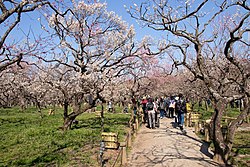Kairaku-en
| Kairaku-en | |
|---|---|
| 偕楽園 | |
 | |
 Kairaku-en | |
| Type | Urban park |
| Location | Mito, Ibaraki, Japan |
| Coordinates | 36°22′23″N 140°27′22″E / 36.373056°N 140.456111°ECoordinates: 36°22′23″N 140°27′22″E / 36.373056°N 140.456111°E |
| Area | 300 hectares |
| Created | 1 July 1842 |
Kairaku-en (偕楽園) (English: "A park to be enjoyed together") is a Japanese garden located in Mito, Ibaraki Prefecture, Japan. Along with Kenroku-en and Koraku-en, it is considered one of the Three Great Gardens of Japan.
Overview[]
Kairakuen was built in the year 1842 by Tokugawa Nariaki, daimyō of Mito Domain. Unlike Japan's other two great gardens, Kairakuen was originally intended to serve for the enjoyment of the public, by which Tokugawa Nariaki meant the samurai class. Ordinary commoners were admitted only on certain dates each year. The gardens are especially noted for the plum blossom season, which usually takes place in late February and March. Besides the plum tree grove, where one hundred different plum tree varieties with white, pink and red blossoms are planted, Kairakuen also features a bamboo grove, cedar grove, and the Kobuntei, a three-story pavilion for use in poetry contests and for the Japanese tea ceremony.
Following the Meiji restoration, the park became property of the Japanese government, and the Tokiwa Jinja, a Shinto shrine was built within its grounds. The garden was officially renamed Tokiwa Park in 1873. In 1922 it was designated a National Historic Site and also a National Place of Scenic Beauty.[1] The Kobuntei pavilion burned down in 1945 during the bombing of Mito in World War II, but was restored in 1958. The name of the park was also officially changed to "Kairakuen" in 1948. The total area of the park is 300 hectares. It is served by Kairakuen Station on the JR East Jōban Line, but the station is only open during the plum blossom season. Sakurayama, noted for its cherry blossoms in April, is part of the park area, but is located on the opposite side of the train tracks.
Gallery[]

Old front gate

Bamboo grove and cedar woods
Koubuntei

Koubuntei

Plum trees

South garden

Kairaku-en Park and Koubuntei
See also[]
- Kōdōkan
- List of Historic Sites of Japan (Ibaraki)
- List of Places of Scenic Beauty of Japan (Ibaraki)
References[]
- ^ "常盤公園" [Tokiwa Koen] (in Japanese). Agency for Cultural Affairs. Retrieved 20 August 2020.
External links[]
| Wikimedia Commons has media related to Kairaku-en. |
- Gardens in Japan
- Mito, Ibaraki
- Gardens in Ibaraki Prefecture
- Historic Sites of Japan
- Places of Scenic Beauty
- 1842 establishments in Japan









